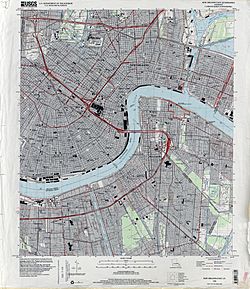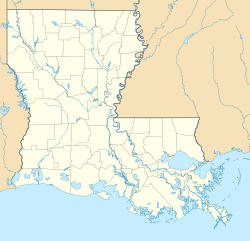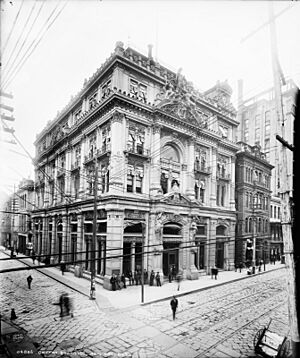New Orleans Cotton Exchange facts for kids
|
New Orleans Cotton Exchange Building
|
|
|
U.S. Historic district
Contributing property |
|
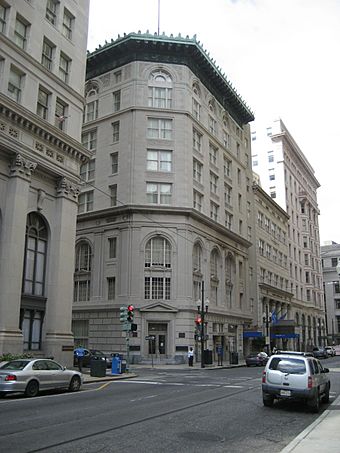 |
|
| Location | 231 Carondelet Street, New Orleans, Louisiana |
|---|---|
| Built | 1921 |
| Architect | Favrot & Livaudais Ltd.; Selden-Breck Construction Co. |
| Architectural style | Chicago |
| Part of | New Orleans Lower Central Business District (ID91000825) |
| NRHP reference No. | 77000675 |
Quick facts for kids Significant dates |
|
| Added to NRHP | December 22, 1977 |
| Designated NHL | December 22, 1977 |
| Designated CP | June 24, 1991 |
The New Orleans Cotton Exchange was a very important place in New Orleans, Louisiana. It started in 1871 to create a central spot for buying and selling cotton. This exchange helped organize the cotton trade until it closed in 1964. The building where it was last located, called the New Orleans Cotton Exchange Building, is now a special place known as a National Historic Landmark.
Contents
History of the Cotton Exchange
Why the Exchange Was Needed
The New Orleans Cotton Exchange was created by a group of people who bought and sold cotton. At that time, about one-third of all the cotton grown in the United States passed through New Orleans. The cotton market was often confusing, with prices changing a lot. The Exchange wanted to make things more orderly. It gave people involved in the cotton business a central office. Here, they could get information about market conditions and prices. The Exchange also set rules for how cotton was sorted and helped buyers and sellers make payments.
Starting the Exchange
The New York Cotton Exchange opened in 1870. Merchants in New Orleans worried that trading cotton in New York might be better for buyers than for sellers. They also wanted to make their own operations more modern. So, New Orleans merchants decided to start their own exchange. The New Orleans Cotton Exchange officially opened on February 20, 1871. It was located at the corner of Gravier and Carondelet Streets. This area was already popular with cotton merchants.
New Ways of Trading Cotton
The Exchange became famous for its smart ways of gathering information about the cotton market. A man named Col. Henry G. Hester, who was the secretary for many years, led these efforts. Reports were put together and then sent by telegraph. This was a very new and fast way to share information back then. Col. Hester also brought the idea of futures trading to the Exchange. This meant people could agree to buy or sell cotton at a set price in the future. These modern business methods helped the local cotton market a lot. New Orleans became a top spot for cotton trading worldwide. It was only behind Liverpool and New York in futures trading.
The Exchange's Later Years
Over time, the New Orleans Cotton Exchange became less important. Many things caused this decline. The end of slavery changed how cotton was produced. Market conditions kept changing, and the government added new rules and price supports. Also, cotton farming in the Southern United States began to shrink. All these factors led to a big drop in the Southern cotton market. The Exchange finally closed its doors in 1964. A few attempts were made later to start a similar exchange, but none of them worked out.
The Cotton Exchange Building
Early Locations
When the Exchange first opened in 1871, it rented rooms in a building at Gravier and Carondelet streets. Even though they moved several times, the Exchange stayed at this intersection until it closed in 1964. After building and then outgrowing a smaller building nearby, the Exchange built a grand new building in 1881. This building was at the northern corner of Gravier and Carondelet. It was known for its fancy inside design and quickly became a famous landmark in the city.
Building a New Home
However, in 1916, the 1881 building was found to be unsafe. Plans began for a new building to replace it. World War I and other issues caused delays, so construction didn't start until 1920. The original plans for an equally grand replacement building had to be made smaller.
The building that was finally built was simpler. It looked like a Renaissance palazzo, which is a type of Italian palace. The architects were Favrot and Livaudais. The Cotton Exchange used this building until it closed in 1964. They sold the building in 1962 and just rented space for their last two years of operation.
The building was added to the National Register of Historic Places in 1977. It was also named a National Historic Landmark, which is an even higher honor. In early 2023, a group of investors bought the first two floors of the building. A company called JECohen has its main office on the second floor. The first floor is being updated for a new store or restaurant.
Degas's Painting
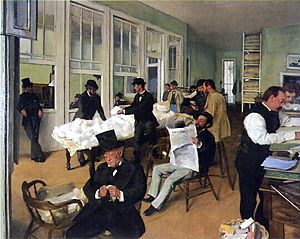
The famous French artist Edgar Degas painted a picture of a cotton office in 1873. He painted it while visiting his mother's family in Louisiana.
Some people think the painting shows the Cotton Exchange. However, the painting actually shows the office of a cotton factor in a nearby building. This building was known as "Factors' Row."
See also
- Cotton factor
- New York Cotton Exchange, the first cotton exchange in the U.S.
- Mobile Cotton Exchange, the third cotton exchange in the U.S.
- Memphis Cotton Exchange, founded 1874
- Cotton production in the United States
- List of National Historic Landmarks in Louisiana
- National Register of Historic Places listings in Orleans Parish, Louisiana
- JECohen


